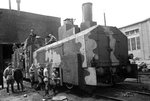parsifal
Colonel
THis kinda makes me wonder and Tzar1 touched up this earlier.
If 30k were built, 11k were lost in combat ad there were at most 12k in service, what happened to the other 7k??
I dont know, but it is quite normal that only a fraction of aircraft ever get used operationally. For the US only about 40% of its aircraft produced during the war were committed to operational units. The remainder generally ended up as landfill after the war.
Its normal for an air force to hold back significant numbers of aircraft as reserves and still others to be assigned to OCUs and other training elements.
7000 unnaccounted airframes is actually a fairly low number as a proportion of the total. It suggest the Soviets were not running huge numbers in their reserve elements, and/or did not have a particulalry large training establishment.
I'll bet the losses stated in this thread dont include noncombat losses.
As a general rule of thumb it was quite normal under wartime conditions for combat units to suffer an average of 5-8% attrition due to non-combat related causes in any given month. It was this high because aircraft were often called upon to exceed their safe working limits interms of range, or payload, or both, and were often made to fly in conditions that in peacetime would be considered unsuitable. All nations, to a greater or lesser extent, considered their aviators to be expendable if the battle situation demanded it.

